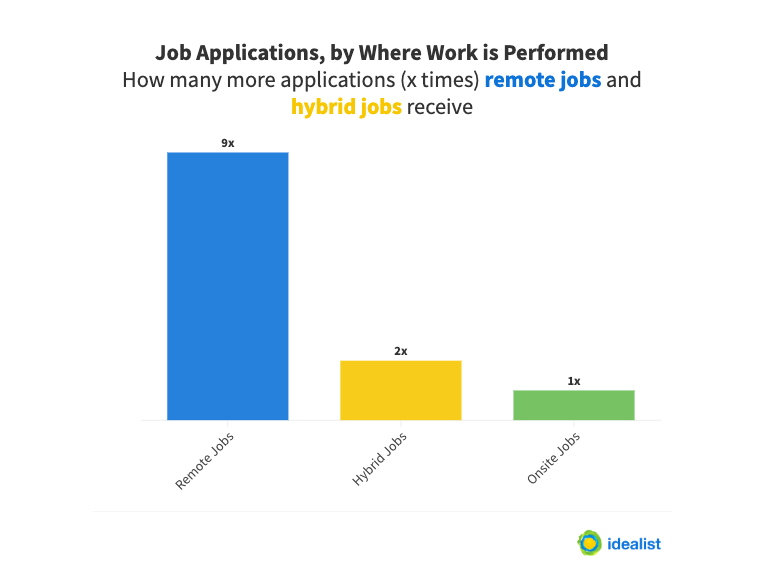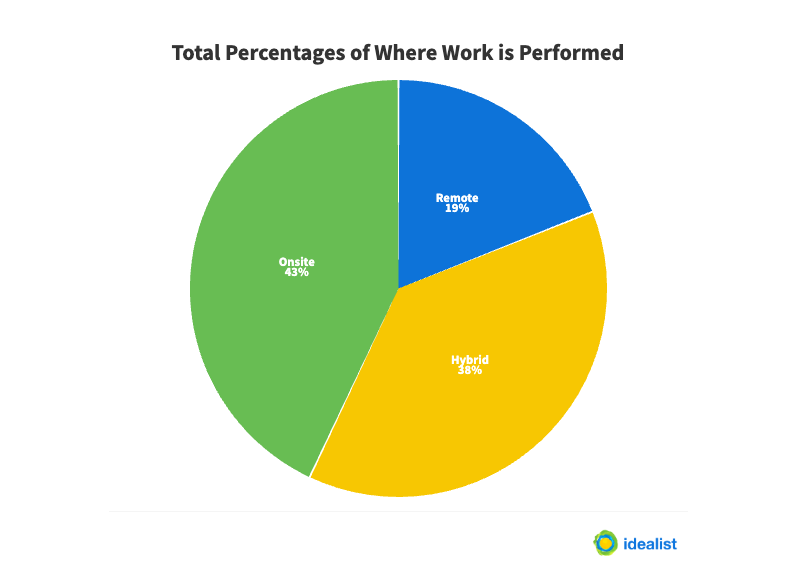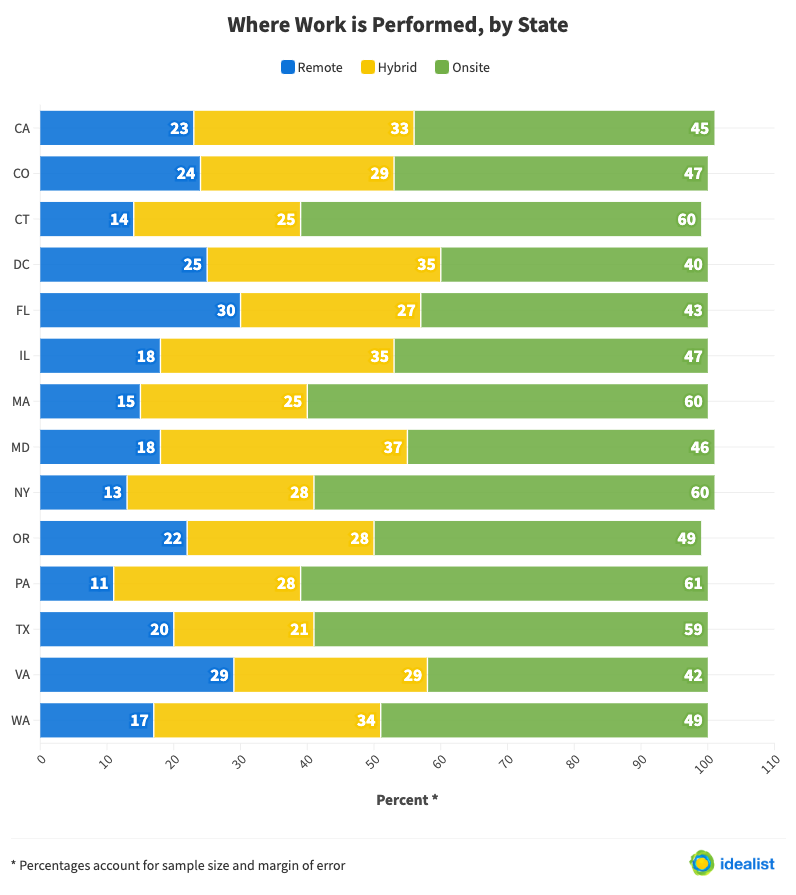Remote work is not going away.

Audience Success at Idealist
Some may greet this with cheers; others with woe. The past few years have shown that, for better or worse, work has indelibly changed. At Idealist, the largest nonprofit job board in the country, we’ve observed this evolutionary change through two lenses: one, from the perspective of social-impact organizations who use us to find great talent, and two, from that of job seekers pursuing social-impact careers. Where work is performed is becoming one of the more complicated and nuanced human resources issues of our time.
With this emerging trend in mind, we’ve aggregated an enormous amount of data from nonprofit job listings and searches, telling a complete story from both sides of the hiring landscape.
Before we look at the data, here’s some context around remote work:
- The ability to work remotely is something job seekers increasingly desire, whether for convenience (like lack of a commute), relocation to a less populated area, health concerns, such as those related to the ongoing COVID pandemic, or other reasons.
- But employers know all too well that some roles must remain onsite, especially in direct services. These organizations may require that all employees work onsite or on a hybrid basis (a combination of onsite and remote) when some positions need to be onsite, citing equity as the main reason. Still other nonprofits may not allow fully remote work because of tradition, manager preference, or other concerns.
- We’d argue that remote work can open up opportunities for searches that produce a more diverse pool of candidates – people who may not be local but who are qualified and would bring new perspectives to your organization, or people with mobility issues that do not allow them to easily and regularly travel to an office.
The data on remote work searches
While most data in this article are about nonprofit employers, we wanted to start with a little bit about job seekers.
- We’ve seen use of our search filters rocket upward after 2019 and, digging deeper, we can see that most people who use filters use “location.” Of the folks who use this, 88 percent are looking for a remote job, 7 percent are looking for hybrid work, and 5 percent are looking for an onsite position.
- When comparing job applications for roles at organizations using Idealist’s Applicant Tracker, remote positions receive nine times as many applications as onsite jobs.

Overall work location trends at nonprofits
To get a sense of baseline, we looked at some of the overall numbers, almost 60,000 data points representing nonprofit jobs posted to idealist.org and salaries submitted to our nonprofit salary tool (more on these data sources at the end of this article).
- Looking at the data, about 43 percent are onsite jobs, 38 percent of jobs are hybrid, and 19 percent of jobs are fully remote.

Focusing specifically on our nonprofit salary tool, that database provides fascinating insight on how employers are beginning to determine location-based pay. Drawing on over 13,000 salaries submitted by nonprofit professionals, we found that an average of 73 percent of positions were compensated based on the employer’s location, while about a quarter were paid based on employee location.
In part because of this tendency to base pay on employer location, job seekers who live in locations with a lower cost of living may be attracted to remote jobs with higher salaries than can be found at local organizations. On the other side of the coin, these same local organizations still need staff to further their mission, but often can't compete with higher salaries paid to local residents working remotely.
Factors that impact where work is performed
On idealist.org, organizations can post – and job seekers can search – using different facets related to both a specific role and an organization. Because of this, we can see what factors may or may not impact where work is performed. Here are a few of them:
Education level
- Out of all education levels, people with a high school diploma or G.E.D. are most likely to work onsite (75 to 79 percent). Flowing from that, they are least likely among all social-impact professionals to work in a hybrid set-up (13 to 19 percent).
- Those with law degrees are more likely than others to work in a hybrid set-up (45 to 51 percent). On a related note, they are least likely to be onsite (37 to 43 percent).
- Those with a doctorate are most likely to be fully remote (26 to 54 percent).*
- The least likely to work remotely are those with a high school diploma, G.E.D., or two-year degree (4 to 14 percent).
* A note about the data: you may notice the wide range here, representing a large margin of error. This is due to the smaller sample size of positions requiring a Ph.D., Ed.D., or similar. Even when accounting for this, the lower end of the range is still a higher percentage than any other education level.
Role type
- Some other roles in the sector are more likely to require onsite work, as well. For example, 100 percent of those working in animal care are onsite.
- Facilities / maintenance: 90 to 100 percent onsite
- Education: 83 to 93 percent onsite
- Then, of course, there are roles that can be performed anywhere, with some in-person responsibilities. For instance, 37 to 43 percent of fundraising / development jobs maintain a hybrid work set-up.
- Legal: 33 to 47 percent hybrid
- Marketing / communications: 33 to 41 percent hybrid
- Other roles lend easily to fully remote work, such as research (38 to 60 percent).
- Business development: 30 to 52 percent remote
- Information technology: 26 to 44 percent remote
Job level
- The data clearly show there are equity concerns related to where work is performed. As was mentioned before, in general, about 43 percent of nonprofit sector jobs are fully onsite.
- Breaking down data by job level, however, we see that assistant and associate / coordinator roles are well over this threshold for onsite work (56 to 68 percent and 51 to 55 percent, respectively).
- Roles from manager-level to upper-level management roles are all less likely to work onsite (at an average of 41 to 44 percent). These roles are more likely to be remote than assistant, associate, or coordinator roles.
- Once the job level reaches the head of the organization, they are more likely to be onsite (47 to 57 percent).
Organization size
- The size of an organization doesn’t seem to strongly indicate whether employees are remote or not. Organizations of fifty staff or fewer are somewhat more likely to work remotely than organizations of fifty or more, but the difference isn’t off the charts. More specifically:
- 13 to 23 percent of employees in organizations of 1000 staff or more are working remotely.
- 19 to 27 percent of employees in organizations of 1-10 staff are working remotely.
Organization type
- There are some clear distinctions among organizations of different types and in where work is performed, related to the organization’s focus. For instance, 27 to 43 percent of think tanks / policy institutes work remotely. 22 to 32 percent of membership organizations tend to work remotely.
- Far and away, those working in public or private K-12 schools are mostly likely to be onsite (76 to 82 percent).
The impact of location on where work is performed
Perhaps unsurprisingly, location has an effect on where work is performed. In the table below, you can see state data by percentage, based on where Idealist has the most data. *

A note about the data: as already stated, there are more onsite jobs than remote or hybrid jobs. Because of this, many data sets pertaining to remote or hybrid roles are too small to report on with enough confidence, even when onsite job data sets are large. Here, we are presenting data when all three data sets are of significant size.
Of course, the statewide data don’t account for variations in metropolitan areas – e.g., what’s accepted as the standard practice in Los Angeles is not what will be standard in rural northern California. Still, this gives a sense of what trends may be occurring across the country.
Where do we go from here?
While there are many positives in the increased availability of flexible work arrangements, in some cases there seems to be a divide between what many social-impact job seekers want and what many social-impact organizations are able to provide. What’s clear is that work has changed; there are many open roles and many professionals looking for work. At Idealist, we’ll continue to be a bridge between these communities, hoping to bring everyone together in the shared space of a common goal: building a better world.
Data sources
For most of the data presented in this article, we analyzed two main data sets: jobs posted by employers, and salary data posted by employees. At different times we relied on one or the other, depending on which had more data points. In some cases, an average of both sets was used for a fuller picture of the situation. More specifically, the data included:
- 45,891 nonprofit jobs posted on idealist.org from August 30, 2022 - June 15, 2023 (“jobs”).
- 13,619 submissions to our nonprofit salary tool, Idealist Salaries, from August 30, 2022 - June 15, 2023 (“salaries” or “salary tool”). [Editorial note: staff members at the National Council of Nonprofits served on the advisory board in support of this product.]
- Four years of job searches performed on idealist.org (2019-2022), where about two thousand users on average use the location search filter every day.
Emily Hashimoto (they/them) is the Director of Audience Success at Idealist, focused on supporting social-impact professionals in their job searches and professional development. Before serving in this role, Emily worked extensively with nonprofit human resources and operations teams to ensure they made the most of Idealist. Prior to their time at Idealist, Emily worked in government, political campaigns, advocacy, and higher education.
